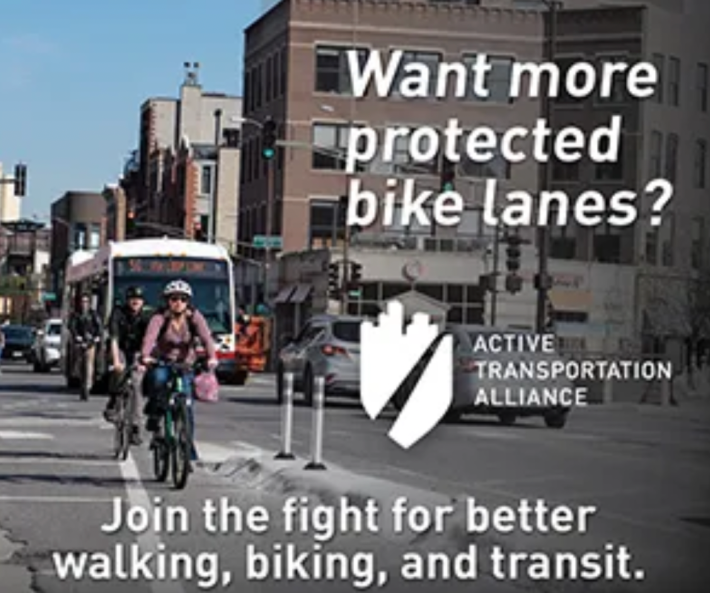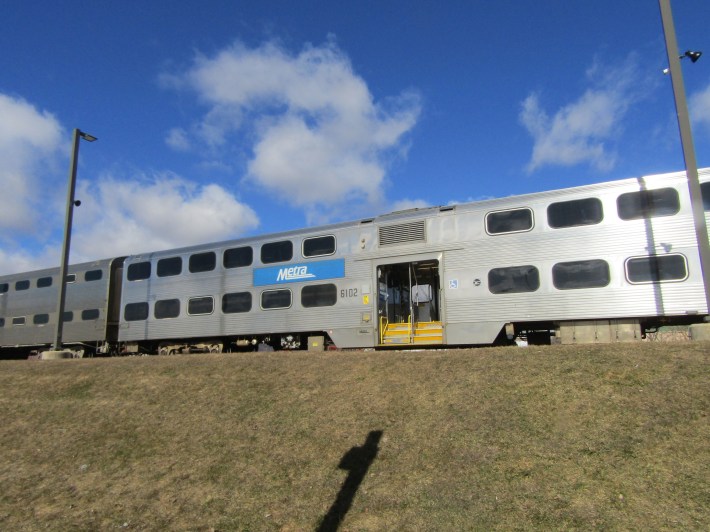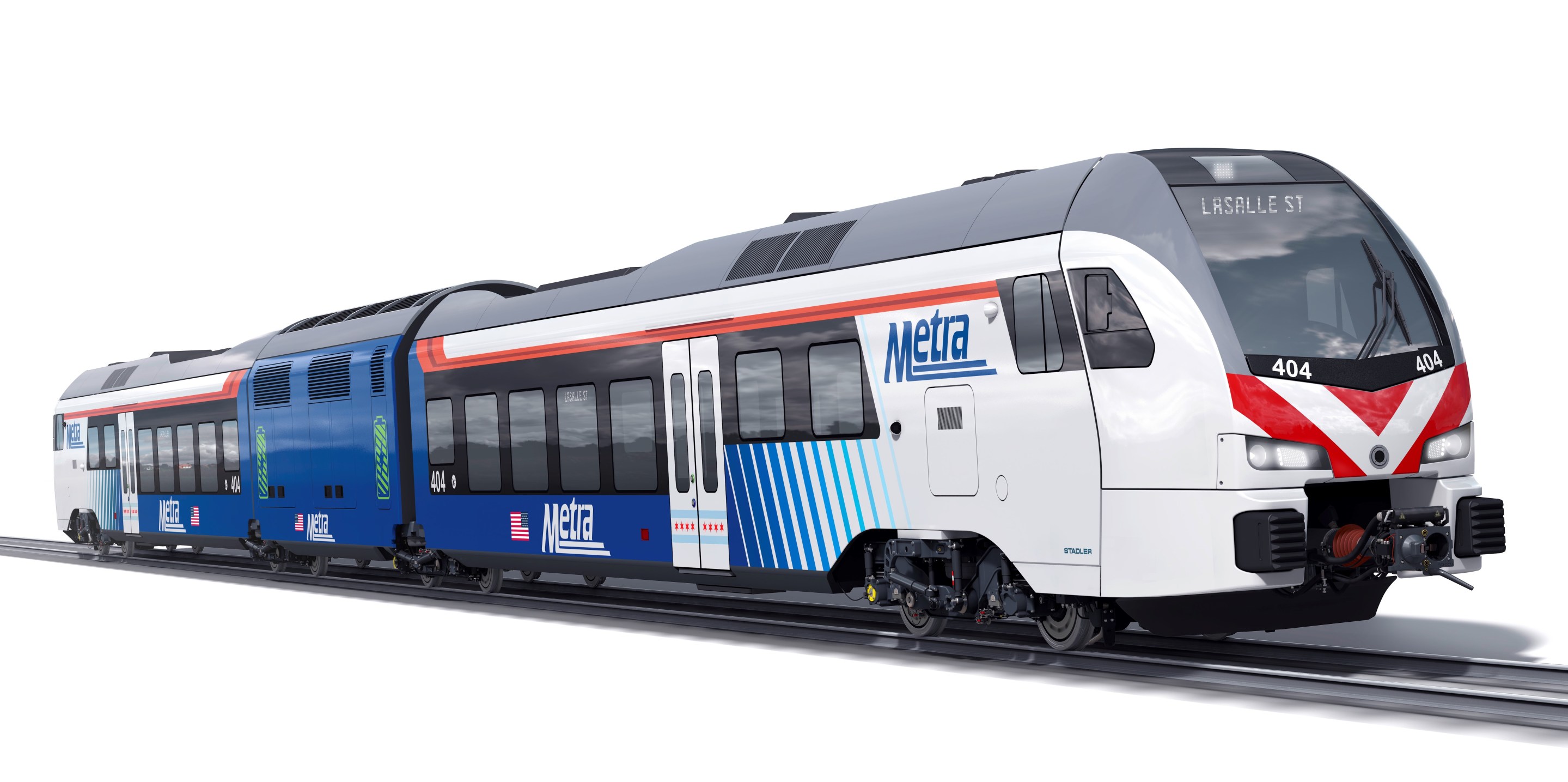
Wednesday was a good day for Metra’s train fleet.
As Metra's board of directors authorized the commuter railroad to buy eight battery-powered Stadler train sets, the U.S. Department of Transportation announced Metra will get $100 million to buy 50 Alstom Transportation bi-level rail cars. According to Metra spokesperson Michael Gillis, this will be on top of the 200 Alstom cars the agency has already ordered.
Replacing rail cars and locomotives has been a major priority for Metra. While the overhead catenary-powered Metra Electric District trains have been completely replaced over the past 20 years, the rest of the lines still use train cars and locomotives that, according to Metra, average 34-35 years old. The oldest passenger cars in the fleet date back to 1950s, and nearly a quarter of the train cars date back to 1970s and 1980s.
Metra expects the battery-powered trains to arrive in 2027 at the earliest. It’s less clear when the Alstom cars will arrive, considering that the initial order is running behind schedule, and the first cars aren’t expected to arrive until August 2025 at the earliest.
Metra expects to first deploy the Stadler train sets on the Rock Island District line’s Beverly branch, while the Alstom cars will be used to replace the oldest train cars in the fleet. That means that a lot of them will end up on the three Union Pacific lines.
Stadler battery-powered trains
In some ways, the Stadler trains will be familiar to MED riders. The train engineer cabs will be at the front and the back of the train sets, riders won’t need to climb up and down the stairs to board and leave trains, and doors will be open between cars to let riders freely walk between them. But, in a dramatic departure from Metra design practices, the trains will be single-level. That means that they won’t be suitable for MED’s high-level platforms. The trains will have lifts for people with wheelchairs, and other mobility aids. They'll be sort of like souped-up version of the Hop streetcar train sets.
Metra is initially ordering eight two-car train sets, each of which can seat up to 112 people. By comparison, a single MED Highliner train car can seat up to 128 people. The cars will have bike racks, luggage racks and USB chargers. The contract gives Metra an option to buy up to eight more train sets and 32 trailer cars that can be added to train sets to increase capacity. Each trailer car will be able to seat 46 people. Half of the trailer cars wi have ADA-compliant restrooms. That option will cost Metra up to $181.4 million – the exact amount will depend on how many train cars it ends up ordering.
In its press release, the railroad described the new train sets as “a more economical and environmentally friendly way to provide the same level of service or better, particularly during off-peak times.” It also touted reducing pollution on the South Side. The battery is expected to hold the charge for up to 45 to 65 miles of trave. That's more than enough for the round trip most Beverly branch trains currently make between the LaSalle Street terminal and the Blue Island station, a distance of 16.4 miles in each direction.
Metra is using the $169.3 million federal Congestion Mitigation and Air Quality Improvement (CMAQ) funds to cover 80 percent of the initial order. The rest will come from PAYGO funds, the revenue Illinois transit providers get from bond sales. The railroad expects the first train cars to be delivered in 2027 or 2028.
During the board meeting, Metra CEO Jim Derwinski described the order as a major milestone. “This program lets us raise a flag to say we're leading in this area in the country. We are the only commuter railroad that will have zero emissions, battery-powered train sets."
Derwinski said that while the train sets’ batteries are expected to last eight years, he hopes that they will last longer than that, citing those batteries performed longer in electric vehicles than expected “[The biggest test is] how will they perform in Chicago and the type of heat we have and the type of cold we have.”

Alstom orders
Metra chose Alstom, a French rolling stock manufacturer with an extensive US presence, to manufacture the new bilevel train cars back in 2021. As Streetsblog reported at the time, it will feature two separate “decks” as opposed to the gallery-style design that lets conductors check tickets on both levels, and it features level boarding, so the riders don’t have to climb stairs or use a lift to get into the vestibule.
Metra has the option of buying up to 500 rail cars on top of the 200 it already ordered. During yesterday's board meeting, Metra chief mechanical officer Kevin Clifford said that the original order is running behind schedule, saying that Alstom is still finalizing the design. “As for delivery, we should have our first car on site in 2025, and full-scale production should begin in mid-2027."
Also yesterday, the FTA announced that Metra was one of the three commuter rail providers to get Rail Vehicle Replacement Program funding, getting $100 million out of $631 million. The program was among the several programs approved as part of the Bipartisan Infrastructure Law to improve transit systems throughout the country.
Gillis said Metra will need to provide $100 million in matching funds. “Both the base order purchase of 200 cars and the option for 50 more will allow us to replace and retire the oldest cars in our fleet, some of which date to the 1950s."
In the FTA press release, U.S. Transportation Secretary Pete Buttigieg said that the grants are important because many railcars are decades old and in need of replacement. “Through President Biden’s infrastructure law, we’re proud to deliver 300 new railcars to give Americans a safer, more comfortable, more reliable service on America’s rails."
The state of Metra fleet
During yesterday's board meeting, Clifford and Sean Cronin, the head of Metra’s mechanical capital projects. gave a general update on the state of the Metra fleet.
The railroad currently has 854 bilevel passenger cars, 171 locomotives and 186 catenary-powered trains. Metra considers 40 years of service a benchmark for replacing passenger cars. But according to the presentation 17 passenger cars currently in service date back to the 1950s, 134 cars date back to the 1960s and 166 date back to the 1970s.
According to the presentation, the number of passenger cars rated in "poor" condition rose to 338 in 2023. Cronin emphasized that “poor doesn't mean unsafe,” but he and other Metra officials previously indicated that the older the train equipment gets, the harder and more expensive it gets to repair.
If the Stadler and Alstom cars arrive without further delays, Metra expects to be able to take its oldest passenger cars out of service by 2029. But Cronin warned that the issue will rear its head again in the late 2040s as cars that are currently less than 40 years old age.

Did you appreciate this post? Please consider making a tax-deductible donation to help Streetsblog Chicago keep publishing through 2025. Thank you.





